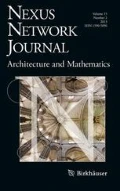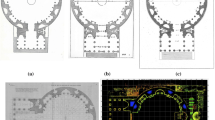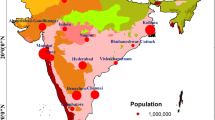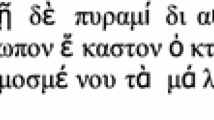Abstract
Located in the District of Zeyrek in Istanbul, Turkey, and completed in the 1960s, the Sosyal Sigortalar Kurumu (SSK) or Social Security Agency Complex is currently accepted as one of the most important works of the architect Sedad Hakkı Eldem as well as one of the key modern buildings in Turkey. The most admired characteristic of this complex is how it is harmonically integrated into its historical context, which was once an urban fabric consisting of vernacular Turkish houses, but has changed significantly to its present condition. To evaluate this claim of harmony in a measurable manner, the present paper uses fractal dimension analysis in four hierarchical layers of consecutively diminished complexity. Thus, it is possible to measure the visual complexity of both the SSK Complex and its historical context in a comparative manner and gain insights about the frequently claimed visual harmony.















Similar content being viewed by others
References
Akcan, Esra. 2016. Global Conflict and Global Glitter: Architecture of West Asia 1960–2010. In A Critical History of Contemporary Architecture, ed. Ellie G. Haddad and David Rifkind, 311–338. New York: Routledge.
Batty, Michael and Paul Longley. 1994. Fractal Cities: A Geometry of Form and Function. New York: Academic Press.
Bechhoefer, William and Carl Bovill. 1994. Fractal Analysis of Traditional Housing in Amasya, Turkey. Traditional Dwellings and Settlement Review 6(1): 14–15.
Bechhoefer, William and Marilyn Appleby. 1997. Fractals, Music and Vernacular Architecture: An Experiment in Contextual Design. In Critical Methodologies in the Study of Traditional Environments (Working Paper Series, vol. 97), ed. Nezar Al Sayyad (Unpag.) Berkeley: University of California at Berkeley.
Bovill, Carl. 1996. Fractal Geometry in Architecture and Design. Boston: Birkhäuser.
Bozdoğan, Sibel. 2001. Modernism and Nation Building: Turkish Architectural Culture in the Early Republic. Seattle and London: University of Washington Press.
Bozdoğan, Sibel, Süha Özkan, and Engin Yenal. 1987. Sedad Eldem: Architect in Turkey. Singapore: Concept Media.
Burkle-Elizondo, Gerardo, Nicoletta Sala, and Ricardo Valdez-Cepeda. 2014. Geometric and Complex Analyses of Maya Architecture: Some Examples. In Architecture and Mathematics from Antiquity to the Future, vol. I, ed. Kim Williams and Michael J. Ostwald, 113–126. Basil: Birkhäuser.
Çağdaş, Gülen, Gaye Gözübüyük, and Özgür Ediz. 2005. Fractal Based Generative Design for Harmony Between Old and New. In Generative Art 2005: Proceedings of 8th Generative Art Conference, Milan, Italy, 15–17 December, ed. Celestino Soddu, 150–159. Milan: Domus Argenia.
Ediz, Özgür. 2003. A Generative Approach in Architectural Design Based On Fractals (Mimari Tasarımda Fraktal Kurguya Dayalı Üretken Bir Yaklaşım). Ph.D. thesis, Istanbul Technical University.
Ediz, Özgür. 2009. “Improvising” Architecture: A Fractal Based Approach. In Computation: The New Realm of Architectural Design: 27th eCAADe Conference Proceedings, ed. Gülen Çağdaş and Birgül Çolakoğlu, 593–598. Istanbul: Faculty of Architecture, Istanbul Technical University.
Ediz, Özgür and Gülen Çağdaş. 2004. A computational architectural design approach based on fractals at early design phases. In eWork and eBusiness in Architecture, Engineering and Construction, ed. Attila Dikbaş and Raimar Scherer, 635–640. London: Taylor and Francis Group plc. https://doi.org/10.1201/9780203023426.ch85.
Ediz, Özgür and Gülen Çağdaş. 2007. A Computational Architectural Design Model Based On Fractals. Open House International 32(2):36–45.
Ediz, Özgür and Michael J. Ostwald. 2012. The Süleymaniye Mosque: a computational fractal analysis of visual complexity and layering in Sinan’s masterwork. ARQ Architectural Research Quarterly 16(2): 171–182. https://doi.org/10.1017/S1359135512000474.
Eldem, Sedad Hakkı. 1970. Sosyal Sigortalar Kurumu, Zeyrek (Social Security Complex, Zeyrek, Istanbul). Unpublished manuscript, Sedad Hakkı Eldem Archive, SALT Research Center, Istanbul.
Eldem, Sedad Hakkı. 1980. Toward a Local Idiom: A Summary History of Contemporary Architecture in Turkey. In Conservation as Cultural Survival, ed. Renata Holod, 89–99. Philadelphia: Aga Khan Award for Architecture.
Eldem, Sedad Hakkı. 1983. Sedad Hakkı Eldem: 50 Yıllık Meslek Jübilesi, Istanbul: Mimar Sinan Üniversitesi.
Eldem, Sedad Hakkı. 1984. Turkish Houses Ottoman Period, vol. I–III. Istanbul: T.A.Ç. Vakfı Yayını.
Foroutan-Pour, K., P. Dutilleul, and D.L. Smith. 1999. Advances in the implementation of the boxcounting method of fractal dimension estimation. Applied Mathematics and Computation 105(2):195–210. https://doi.org/10.1016/S0096-3003(98)10096-6.
Gözübüyük, Gaye, Gülen Çağdaş, and Özgür Ediz. 2006. Fractal-Based Design Model for Different Architectural Languages. In The Architecture Co-Laboratory: Game Set and Match II: On Computer Games, Advanced Geometries, and Digital Technologies, ed. Kas Oosterhuis and Lukas Feireiss, 280–286. Delft: Episode Publishers.
Imre, A.R. and J. Bogaert. 2004. The Fractal Dimension as a Measure of the Quality of Habitats. Acta Biotheoretica 52(1): 41–56. https://doi.org/10.1023/B:ACBI.0000015911.56850.0f.
Kanatlar, Zeynep. 2012. An Architectural Analysis Based On Fractal Dimension: Sedad Hakkı Eldem and His Residential Architecture (Fraktal Boyuta Dayalı Mimari Bir Analiz: Sedad Hakkı Eldem ve Konut Mimarisi). Master’s thesis, Bursa Uludağ University.
Kuban, Dogan. 1985. A Survey of Modern Turkish Architecture. In Architecture in Continuity Building in the Islamic World, ed. Sherban Cantacuzino, 64–75. Victoria: Aperture Islamic Publications Ltd.
Lorenz, W.E. 2003. Fractals and Fractal Architecture. Vienna: Department of Computer Aided Planning and Architecture, Vienna University of Technology.
Lu, Yongmei and Junmei Tang. 2004. Fractal Dimension of a Transportation Network and its Relationship with Urban Growth: A Study of the Dallas-Fort Worth Area. Environment and Planning B: Planning and Design 31(6): 895–911. https://doi.org/10.1068/b3163.
Mandelbrot, Benoit B. 1977. Fractals: Form, Chance, and Dimension. San Fransisco: WH Freeman and Company.
Neal, F. Brent and John C. Russ. 2012. Measuring Shape. Boca Raton: CRC Press and Taylor & Francis.
Oshida, Y., A. Hashem, T. Nishihara, and M.V. Yapchulay. 1994. Fractal Dimension Analysis of Mandibular Bones: Toward a Morphological Compatibility of Implants. Bio-Medical Materials and Engineering 4(5): 397–407. https://doi.org/10.3233/BME-1994-4506.
Ostwald, Michael J. 2013. The Fractal Analysis of Architecture: Calibrating the Box-Counting Method Using Scaling Coefficient and Grid Disposition Variables. Environment and Planning B: Planning and Design 40: 644–663. https://doi.org/10.1068/b38124.
Ostwald, Michael J., Josephine Vaughan, and Chris Tucker. 2008. Characteristic Visual Complexity: Fractal Dimensions in the Architecture of Frank Lloyd Wright and Le Corbusier. In Nexus VII: Architecture and Mathematics, ed. Kim Williams, 217–231. Turin: Kim Williams Books.
Ostwald, Michael J. and Josephine Vaughan. 2013. Limits and Errors: Optimising Image Pre-Processing Standards for Architectural Fractal Analysis. Architecture Science (ArS) 7: 1–20.
Ostwald, Michael J. and Özgür Ediz. 2015. Measuring Form, Ornament and Materiality in Sinan’s Kılıç Ali Paşa Mosque: an Analysis Using Fractal Dimensions. Nexus Network Journal: Architecture and Mathematics 17(1): 5–22. https://doi.org/10.1007/s00004-014-0219-3.
Ostwald, Michael J. and Josephine Vaughan. 2016. The Fractal Dimension of Architecture. Birkhäuser.
Özbil, Ayşe. 2014. Sedad Hakkı Eldem’s Typological Analysis of the Turkish House as a Tool for an Operative Design Methodology. Özyeğin University faculty archive. https://faculty.ozyegin.edu.tr/ayseo/files/2014/02/Ozbil_typologicalapproach.pdf. Accessed 13 January 2020.
Qin, Jing, Chuanglin Fang, Yang Wang, Qiuying Li, and Yongjiao Zhang. 2015. A three dimensional box-counting method for estimating fractal dimension of urban form. Geographical Research 34(1): 85–96. https://doi.org/10.11821/dlyj201501008.
Rian, Iasef Md., Jin-Ho Park, Hyung Uk Ahn, and Dongkuk Chang. 2007. Fractal geometry as the synthesis of Hindu cosmology in Kandariya Mahadev temple, Khajuraho. Building and Environment 42(12): 4093–4107. https://doi.org/10.1016/j.buildenv.2007.01.028.
Sakai, S., M. Nakamura, K. Furuya, N. Amemura, M. Onishi, I. Iizawa, J. Nakata, K. Yamaji, R. Asano, and K. Tamotsu. 2012. Sierpinski’s forest: New technology of cool roof with fractal shapes. Energy and Buildings 55: 28–34. https://doi.org/10.1016/j.enbuild.2011.11.052.
Tanyeli, Uğur. 2001. Sedad Hakkı Eldem. Istanbul: Boyut Yayın Grubu.
Vaughan, Josephine and Michael J. Ostwald. 2008. Approaching Euclidean limits: a fractal analysis of the architecture of Kazuyo Sejima. In Innovation, Inspiration and Instruction: New Knowledge in the Architectural Sciences, ANZAScA 08, Newcastle, Australia, 26–28 November, ed. Bruce Forwood, 285–294. Newcastle, NSW: University of Newcastle.
Vaughan, Josephine and Michael J. Ostwald. 2009. Nature and architecture: revisiting the fractal connection in Amasya and Sea Ranch. In Performative Ecologies in the Built Environment: Sustainability Research across Disciplines, ed. Stephen Loo, 42. Launceston: School of Architecture & Design, University of Tasmania.
Vaughan, Josephine and Michael J. Ostwald. 2010. Using fractal analysis to compare the characteristic complexity of nature and architecture: re-examining the evidence. Architectural Science Review 53: 323–332. https://doi.org/10.3763/asre.2010.0024.
Voss, Richard. 1986. Characterization and Measurement of Random Fractals. Physica Scripta T13: 27–32.
Yücel, Atilla. 1983. Contemporary Turkish Architecture. In Mimar 10: Architecture in Development, ed. Hasan-Uddin Khan, 58–68. Singapore: Concept Media Ltd.
Acknowledgements
The drawings in this paper were produced based on a drawing from Sedad Hakkı Eldem (1970), accessed via the digital archives of the SALT Research Center, Istanbul. The AutoDesk AutoCAD 2018 program for educational purposes was used by the authors to produce the drawings and complete the fractal dimension calculations presented in this paper.
Author information
Authors and Affiliations
Corresponding author
Additional information
Publisher's Note
Springer Nature remains neutral with regard to jurisdictional claims in published maps and institutional affiliations.
About this article
Cite this article
Lionar, M.L., Ediz, Ö. Measuring Visual Complexity of Sedad Eldem’s SSK Complex and Its Historical Context: A Comparative Analysis Using Fractal Dimensions. Nexus Netw J 22, 701–715 (2020). https://doi.org/10.1007/s00004-020-00482-4
Published:
Issue Date:
DOI: https://doi.org/10.1007/s00004-020-00482-4




